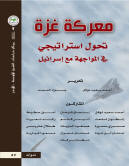شهرية
6
دور مؤسسة القمة العربية ومستقبلها
يناقش هذا الكتاب مجموعة من المحاور المتصلة بدورية مؤسسة القمة من حيث التوجهات والمخرجات والتحديات التي تواجهها، ويتناول فرص تطوير المؤسسة على الصعيد العربي الداخلي والقضايا العربية العامة مع تقديم رؤى وتوصيات نحو تطويرها وتقدمها وتطور دور العرب الدولي، ويؤكد أيضا على دور القوى السياسية والقوى الاجتماعية ومؤسسات المجتمع المدني العربية في المساهمة في إنجاحها.
منذ ابتداء دورية القمة في عمان 2003م لم يجر أي تقييم موضوعي لها ولمخرجاتها، وهي في المحصلة إنجاز سياسي عربي في أن تصبح لقاءات القادة العرب دورية وثابتة بصرف النظر عن غياب بعضهم، أو تغير مستوى التمثيل، أو تكرار المضامين أو عدم تلبية طموح الشارع العربي. وفي هذا المجال يؤكد أصحاب الرأي أن نتاجات القمة العربية كانت سلبية على العرب شعوبا وأنظمة، وليس ما يجري في العراق ولبنان والصومال وغيره بعيدا عن هذه الحقيقة، وأن التأثيرات والتدخلات الخارجية على مؤسسة القمة ما زالت لاعبا رئيسا في أعمال المؤتمرات ونتائجها، في حين أن الأدوار العربية الحقيقية ضعيفة وثانوية إن لم تكن غائبة، في حين يؤكدون أيضا على أن القمة العربية هي الرداء المتبقي للجسم العربي الرسمي، وهي الرابط والخيط الذي ما زال يمثل خيوط العنكبوت للبيت العربي، ولذلك إذا لم تتم تقوية هذا الخيط فإنها ستفقد ما بقي لها من قوة محدودة، وقد تنهار.
وحول دور القوى الشعبية العربية في تفعيل مؤسسة القمة رأى الكتاب أن دخول البرلمانيين العرب تحت مظلة الجامعة العربية يمثل تطورا في تمثيل الأمة العربية بشعوبها ومؤسساتها، مع أنه لا بد من وجود تنظيم من الأحزاب والمؤسسات والقوى العربية ممثلا في الجامعة، ولكن التقصير واضح في هذا الجانب سواء من تلك المؤسسات أو من الأنظمة.
أما فيما يتعلق بمستقبل مؤسسة القمة وسبل تطويرها فيظهر أنه إذا لم تنتبه الأنظمة العربية إلى هموم شعوبها، وإلى الاهتمام بها بعيدا عن الضغوط والإملاءات الخارجية، والسعي نحو تحقيق المصالح العربية المشتركة داخل الدول العربية على مستوى الوطن العربي وعلى مستوى كل قطر على حدة، فإن مستقبلها يؤذن بتراجع أهميتها ودورها إلى درجة فقدان الرابط العربي الأخير على ضعفه.
ويقدم الكتاب عدة مقترحات يمكن أن تخدم في تحقيق أهداف الأمة العربية من القمة ودورها، وأهمها:
· ضرورة توحيد المرجعية والمنهجية العربية في عمل القمة.
· ضرورة الالتقاء على قواسم الاتفاق، وتخفيف حدة الاستقطاب على القضايا الخلافية.
· العمل على حل الخلافات الثنائية بشكل مباشر وقبل أية قمة، والسرعة تشكيل محكمة العدل العربية للبت في الخلافات حيث لزم الأمر.
· الدعوة إلى انتخاب برلمان عربي موحد بشكل مباشر من المواطنين العرب.
الدعوة إلى إنشاء منتدى للأمن القومي العربي المشترك يمثل جهة استشارية للقمة، ومرجعية لحماية الوطن العربي، وكشف التحديات التي تواجهه.
------------------
The Role and Future of the Arab Summit Institution
This book discusses a variety of dimensions related to the Arab summit with regard the trends, outcomes and challenges facing the Arab Summit. It explores opportunities to develop the summits with respect to local and general Arab issues. It also provides visions and recommendations toto develop theArabs’ international role of the Arab people. The book highlightstresses the role of political and social powers and civil institutions in the success of the Arab Ssummit success.
Since the firsstart of the summits in Amman in 2003, the Arab Summits and theirits outcomes have not undergone anybeen systematically evaluatedion. Generally, the percepconviction of the summits, both periodically an d constantlyin the short and long-term, is that of a political achievement. This achievement endures despite the absence of some leaders, changes ining the level of representation, or that they may not meet alling the ambitions of the Arab people. Conversely, sIn this context, some experts claim that the outcomes of the Arab Ssummits were negative ondetrimental to both people and regimes.; Tthe conflicts in Iraq, Lebanon and Somalia are good examples of this.vidence as well as Another criticism is that the interference of other non-member countries has played a dominantmajor role in forming the Arab Ssummitss resolutions’ resolutions. If it exists at all, the Arab roles influence isare weak and secondary. Experts also stresses that the Arab Ssummits are the only remainingleft official connection withibetween the Arab world. If this connection iwas not made strengthenedonger, it will disappearould collapse and destroyed.
As for the role of the Arab people in the activation of the summit institution, tThis book emphasizes that participation ofhaving Arab parliament members in the Arab Lleague would represent be a great step advance in the representation ofing the people and institutions of Arab nations: its people and institutions. Although it is necessary to represent the political parties, Arab institutions and powers in the Arab Lleague, their shortcomings and weaknesses are apparent from those institutions and the regimes are apparent.
IWith regard to the future of the summit institution and the ways to develop it, it seems that if the Arab regimes continues not to pay attention to ignore the concerns of people away where they differ from the policy dictated by outside interference, and at the same timefail to pursueing to fulfill the common Arab interests (on the Arab world level and each country level), the future of the summit institutions would become less significant to a degree that this last Arab connection, although weak,- would be lost.
This book presents several proposals that serve to fulfill whatto meet the expectations of the Arab world expect from the summit institution. The most important aresuggestions would be:
Unify the authority and the methods of summits.
Meet ion a common and joint spirits and decrease polarization over the argumentative disputes.
Establish an Arab Justice Court of Justice to solve bilateral disputes before summits; when necessary.
Electing a unified Arab parliament directly from the people.
Founding a Common Arab Forum for Security to protect the Arab world, specify the challengesthat it faces, and act as consultant to the summit.
|
Designed by Computer & Internet Department in MESC.Latest update August 25, 2011 12:39:27 |























